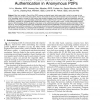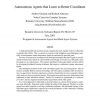3047 search results - page 569 / 610 » On the Meaning of Logical Completeness |
BMCBI
2005
13 years 8 months ago
2005
Background: The recent explosion in the availability of complete genome sequences has led to the cataloging of tens of thousands of new proteins and putative proteins. Many of the...
TPDS
2008
13 years 8 months ago
2008
Most trust models in Peer-to-Peer (P2P) systems are identity based, which means that in order for one peer to trust another, it needs to know the other peer's identity. Hence,...
AAMAS
2004
Springer
13 years 8 months ago
2004
Springer
A fundamental difficulty faced by groups of agents that work together is how to efficiently coordinate their efforts. This coordination problem is both ubiquitous and challenging,...
JSS
2007
13 years 8 months ago
2007
Effort prediction is a very important issue for software project management. Historical project data sets are frequently used to support such prediction. But missing data are oft...
BMCBI
2004
13 years 8 months ago
2004
Background: Hidden Markov Models (HMMs) have proven very useful in computational biology for such applications as sequence pattern matching, gene-finding, and structure prediction...



